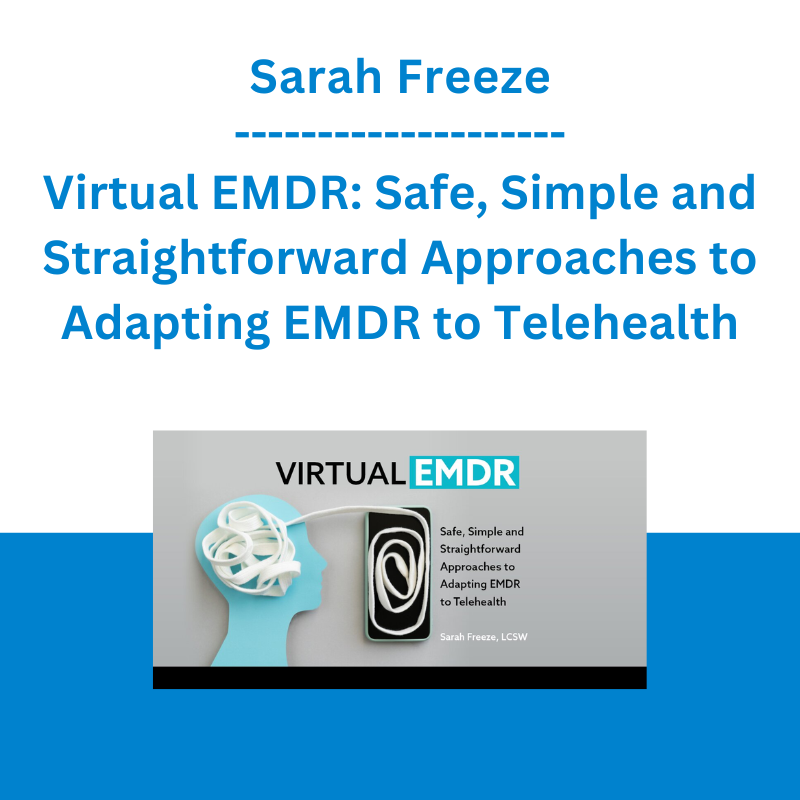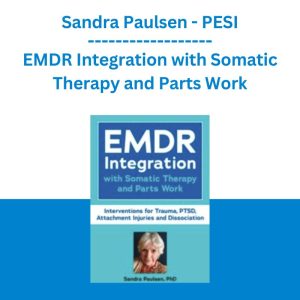*** Proof of Product ***
Exploring the Essential Features of “Sarah Freeze – Virtual EMDR: Safe, Simple and Straightforward Approaches to Adapting EMDR to Telehealth”
Speaker: Sarah Freeze, LCSW
Duration: 12 Hours 27 Minutes
Format: Audio and Video
Copyright: Dec 20, 2023
Media Type: Digital Seminar
Description
Let’s face it, as the demand for effective virtual therapy continues to climb, the need to update and enhance your skills and tools has never been more crucial.
That’s where this training comes in.
With practical guidance, detailed instruction, and expert tips you’ll end this program ready to make your online EMDR sessions more impactful than ever before.
From creating a secure space to adapting bilateral stimulation online, this training turns must-have concepts into easy-to-follow steps that can boost client engagement and enhance your trauma treatment in every phase of the protocol.
Whether you’re new to using EMDR online or have already been trained and are looking to refine your work, you’ll get safe, simple and straightforward strategies for mastering EMDR in the virtual environment so you can:
- Fully immerse clients in the EMDR process – even when they can’t be in the room with you
- Skillfully adapt the 8-phase protocol for telehealth
- Discover easy to use bilateral stimulation tools for remote sessions
- Improve your virtual presence to maximize attunement in each and every session
- Feel fully prepared to handle crisis level trauma reactions
- Implement creative ways for remote resource installation
- Quickly troubleshoot common challenges you face in virtual sessions
- And much more!
In a world where online therapy is the norm, this program ensures you’re not just keeping up – you’re leading the way in delivering impactful and transformative online EMDR sessions.
So don’t wait.
Register now!
Speaker
Sarah Freeze, LCSW
Sarah Freeze, LCSW is a psychotherapist and licensed clinical social worker in private practice based out of Denver, CO. She is a certified EMDR therapist, and her practice includes psychotherapy, consultation, and teaching. She specializes in treating trauma/PTSD and utilizes EMDR, psychodynamic, relational, and Sandtray therapies. Her passion is working with adults who have experienced childhood abuse, neglect and emotional non-recognition, using a person-centered and culturally informed framework. Beyond her private practice, Sarah has clinical experience in community and agency settings, working with children and adults who have experienced sexual abuse, sexual assault, physical abuse, and domestic violence. With a strong background, she takes great care in applying clinical research into practice. Discover more at sarahfreezelcsw.com.
Speaker Disclosures
Financial: Sarah Freeze maintains a private practice and receives compensation as a consultant. She receives a speaking honorarium and recording royalties from PESI, Inc. Sarah Freeze is a paid consultant for Evergreen Certifications. She has no relevant financial relationships with ineligible organizations.
Non-financial: Sarah Freeze is a member of the Colorado Society for Clinical Social Work and the EMDR International Association.
Objectives
- Compare remote intensive trauma-focused treatment models for PTSD and complex PTSD.
- Examine the preliminary research on the effectiveness of remote EMDR therapy in treating PTSD and complex PTSD.
- Evaluate the safety measures implemented in home-based telehealth for intensive treatment.
- Identify key factors influencing the clinician and patient experience in delivering and receiving remote EMDR therapy.
- Assess clients to determine the appropriateness of using EMDR in virtual sessions.
- Analyze the 8 Phases of the EDMR protocol and determine how clinicians can integrate proper adaptations for use in a virtual environment.
- Identify the barriers and risks associated with virtual EMDR.
- Use strategies that can help foster the critical connection between client and therapist in online therapy.
- Utilize applications and online resources for conducting bilateral stimulation remotely with clients.
- Apply techniques to assist clients in de-escalating trauma associated triggers via telehealth.
- Analyze how clinicians can account for cultural difference and physical environments to maximize the effectiveness of therapy via telehealth.
- Administer assessments to individuals participating in internet-based EMDR to measure changes in symptoms and overall mental health.
Outline
The 8 Phases of EMDR and Essential EMDR Resources
- History
- Preparation
- Assessment
- Desensitization
- Installation
- Body scan
- Closure
- Re-evaluation
- Review of resources (calm place, container, ICON, etc.)
Assess the Appropriateness of Virtual EMDR for Clients
- Establishing safety
- Creating Resources
- Dual awareness options
- Informed consent
Common Barriers to Virtual EMDR Treatment
- Keeping a consistent environment
- Distractions
- Checking on physical responses
- Safety in the environment
Ways to Increase Attunement in Virtual EMDR Sessions
- Accounting for cultural differences and physical environments
- How to create close proximity with your camera
- Attuned breathing on virtual platforms
Eye Movement Resources for Telehealth Practitioners Using EMDR
- Bi-lateral stimulation and its importance in the EMDR process
- Dual attention methods (eye movements, tapping, tappers, sound)
- Bilateral stimulation via video
- Butterfly hug
- Congruent tapping
- Sound pulses
- Other eye movement strategies
- Apps and BLS online resources
Addressing Safety in Virtual EMDR:
- How to Manage the Potential Risks of Not Being There In-Person
- Establishing a visually safe environment
- Crisis intervention and safety plans
- Managing/assessing for relapse or maladaptive coping
EMDR for Direct Treatment of Traumatic Memories via Telehealth
- Attachment-based interventions in a disconnected world
- Interweaves for blocked processing
- Treating grief and loss
- Creating connection through parts work
- Working with isolation
- Creating empowerment and self-efficacy from a distance platform
Attachment-Based Trauma and Parts Work with Virtual EMDR
- How attachment styles impact processing
- Identifying the different roles that ‘parts’ play in traumatic healing and survival
- How to utilize and acknowledge ‘parts’ in EMDR processing
- Interventions and techniques to bring ‘parts’ forward for healing
- Techniques and tools for working with addicted ‘parts’ during EMDR
Limitations, Risks, and Further Research
- Current research on telehealth with EMDR
- Addressing barriers and potential risks with telehealth and EMDR
- Making the most of risks and limitations for successful treatment outcomes
Target Audience
- Counselors
- Social Workers
- Marriage & Family Therapists
- Psychologists
- Psychiatrists
- Addiction Counselors
- Therapists
- Psych Nurses
- Case Mangers
- Other Mental Health Professionals
Please see the full list of alternative group-buy courses available here: https://lunacourse.com/shop/










 Sandra Paulsen - PESI - EMDR Integration with Somatic Therapy and Parts Work: Interventions for Trauma, PTSD, Attachment Injuries and Dissociation
Sandra Paulsen - PESI - EMDR Integration with Somatic Therapy and Parts Work: Interventions for Trauma, PTSD, Attachment Injuries and Dissociation  George Fontanills & Tom Gentile - Optionetics Wealth Without Worry Course
George Fontanills & Tom Gentile - Optionetics Wealth Without Worry Course  Crypto Dan - The Crypto Investing Blueprint To Financial Freedom By 2025
Crypto Dan - The Crypto Investing Blueprint To Financial Freedom By 2025  Oliver Velez - Essential Strategy Of Trade For Life
Oliver Velez - Essential Strategy Of Trade For Life  George Fontanills & Tom Gentile - Optionetics 6 DVD Series Home Study Course (Digital Download)
George Fontanills & Tom Gentile - Optionetics 6 DVD Series Home Study Course (Digital Download)  Ed Ponsi - Forex Trading
Ed Ponsi - Forex Trading  Toshko Raychev - Profit System + ITF Assistant
Toshko Raychev - Profit System + ITF Assistant  Greg Loehr - Advanced Option Trading With Broken Wing Butterflies
Greg Loehr - Advanced Option Trading With Broken Wing Butterflies  Jonah Paquette - The “Wow” Factor: The New Ways Clinicians Can Use Awe and Gratitude in Therapy - PESI
Jonah Paquette - The “Wow” Factor: The New Ways Clinicians Can Use Awe and Gratitude in Therapy - PESI  Erik Banks - Alternative Risk Transfer
Erik Banks - Alternative Risk Transfer  Akil Stokes & Jason Graystone - TierOneTrading - Trading Edge 2019
Akil Stokes & Jason Graystone - TierOneTrading - Trading Edge 2019  Atlas API Training - API 570 Exam Prep Training Course
Atlas API Training - API 570 Exam Prep Training Course  Fred Haug - Virtual Wholesaling Simplified
Fred Haug - Virtual Wholesaling Simplified  Dave Landry - Stock Selection Course
Dave Landry - Stock Selection Course  Julie Stoian & Cathy Olson - Launch Gorgeous - Funnel Gorgeous Bundle
Julie Stoian & Cathy Olson - Launch Gorgeous - Funnel Gorgeous Bundle